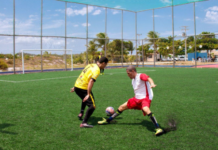Once you experience the excitement and thrill of mountain biking, you can never have enough of it. That being said, it’s no wonder that most novices and keen bikers tend to go mountain biking often, not worrying about the weather or terrain. However, safety should be every single biker’s top priority no matter where you set off. Even if mountain biking is far safer than cycling on the open road, slippery and rough surfaces, untamed terrain and many unforeseen obstacles could damage your bike and even make you slip and fall. To avoid that from happening, here are a few rather nifty safety tips that we have gathered from experienced and professional bikers.
Wear an appropriate helmet
Head protection should be the pivotal thing you bring and wear on your next mountain biking adventure. We can all agree that this sport is utterly exhilarating, but as it does come with some unpredicted dangers, you can never be too protected. Unless you wear an adequate protective helmet you risk fracturing your skull, suffering from severe brain trauma, or even injure your head so badly that you get paralyzed. Most experts suggest wearing a steady but light helmet that fits you meticulously. Too loose or too tight might also lead to other unwanted problems.
Get the best mountain bike
All the experts that we have consulted so far have pointed out that the most important equipment a biker can have is its bike. Hence, finding comfortable and quality mountain bicycles is extremely crucial. And that bike must be solid, lightweight, and provide the rider with optimal performance. Spending more money than planned on a top-of-the-range mountain bike with high-specification components will guarantee a safe and thrilling ride. Before buying, consider whether you need a versatile machine, or a bike for specific purposes, like only for off-trail conditions. Some of the top-notch riding machines cost a few thousand bucks, hence seek advice from reputable retailers before you purchase your bike.
Consider wearing other protective gear
Besides wearing a safety helmet, there are some other inventive and effective items that can reduce the chance of severe injury. If you are keen on riding downhill or are into jumps and passing various challenging obstacles, you should consider wearing body armor. However, if you are not into extreme rides, in that case, experts only recommend wearing gloves, knee, elbow, and arm pads. The reason behind wearing gloves, for instance, is that it significantly reduces the chances of slipping off the bike. You’ll improve your grip on the handlebars of the bike and have better control. Other pads will protect your hands and legs from nasty scratches if you fall off.
Inspect the terrain beforehand
There’s no need to scavenger the entire mountain, but having a clear insight of how the terrain looks like is surely beneficial. This is essential for riders who like to go on road and track races, cycle downhill or uphill and go off the beaten track. Mountain terrain is sometimes unpredictable, but according to experts, it’s a smart idea to ask local rangers, maybe even go hiking on the mountain to inspect the terrain and see whether the terrain is smooth or rough. By knowing whether you have only a few obstructions or a completely bumpy road will determine the level of risk you are about to expect. You could prepare more adequately beforehand and get familiar with the terrain to avoid begin thrown off balance.
Start slow and know your limits
This is vastly significant for novice mountain bikers, as there’ll be terrains and trails that will be too difficult to handle. Whenever you encounter a challenging road, it’s perfectly okay to just get off your bike and walk. Slow down the pace, start small, and build your way to professional routes. Don’t go riding on challenging and dangerous trails as sections that may seem tempting are also pretty risky. Always be prepared for unwanted outcomes to avoid a catastrophe. This involves being concentrated at all times, getting enough rested sleep, and knowing your limits. If you focus more on your general well-being, fitness, and stamina, you’ll be better at riding difficult terrain.
Bring a friend along
When you ride alone, you might get too sassy, automatically the risk of injury skyrockets. Another quite useful tip from professional bikers is inviting a friend or to go riding with you. A solo ride does come with both benefits and perks – you could practice your technique, ride at your own pace, and get that long-awaited “me” time. But a ride with your friends gives steady assurance that you won’t be left behind if you do happen to fall or injure yourself. Plus, bringing a friend along also suggests that they’ll be able to record some of your newly acquired bike maneuvers and post them online for your other friends to see.
Learn some basic first aid
If your bike happens to have a specific pouch attached to the frame of your bike, or you are used to carrying a backpack, a first-aid kit is something you should pack. Along with the kit, it would be advisable to know some basic first aid procedures. Putting a bandage or addressing an injured knee before you seek help will prevent you from suffering any other larger mishaps. You can attend a course, read about providing first aid in the books, or thoroughly inspect a guide online.
Make sure your bike is ready for the challenge
No matter if you’ve bought the best bike on the market, you still have to check before every single ride whether he is ready for the terrain. Firstly, make sure that brakes work properly. Then, check whether there are no broken or loose parts, see whether there’s enough oil on the chains and whether the tires are in perfect condition. Equipment mishaps or technical hitches are a leading cause of numerous accidents in the biking realm. For that reason, most experts advise taking your bike to regular inspections to determine it’s ready for any challenge you’re about to take off.
Prepare for the unexpected
One thing that you always must do is check the weather. Don’t be foolish to go riding when you’ve heard a storm is about to come, etc. Next, have with you a proper bike repair kit. If you notice that your ride is not that smooth, slow down and stop to inspect the bike and if necessary, fix the problem. Dress appropriately and wear glasses for additional eye protection. Carry water, and even bring an extra bottle or two in case you stay longer than planned.
Mountain biking is not for timorous individuals as it takes courage, patience, and diligence to conquer even some of the easiest routes.











